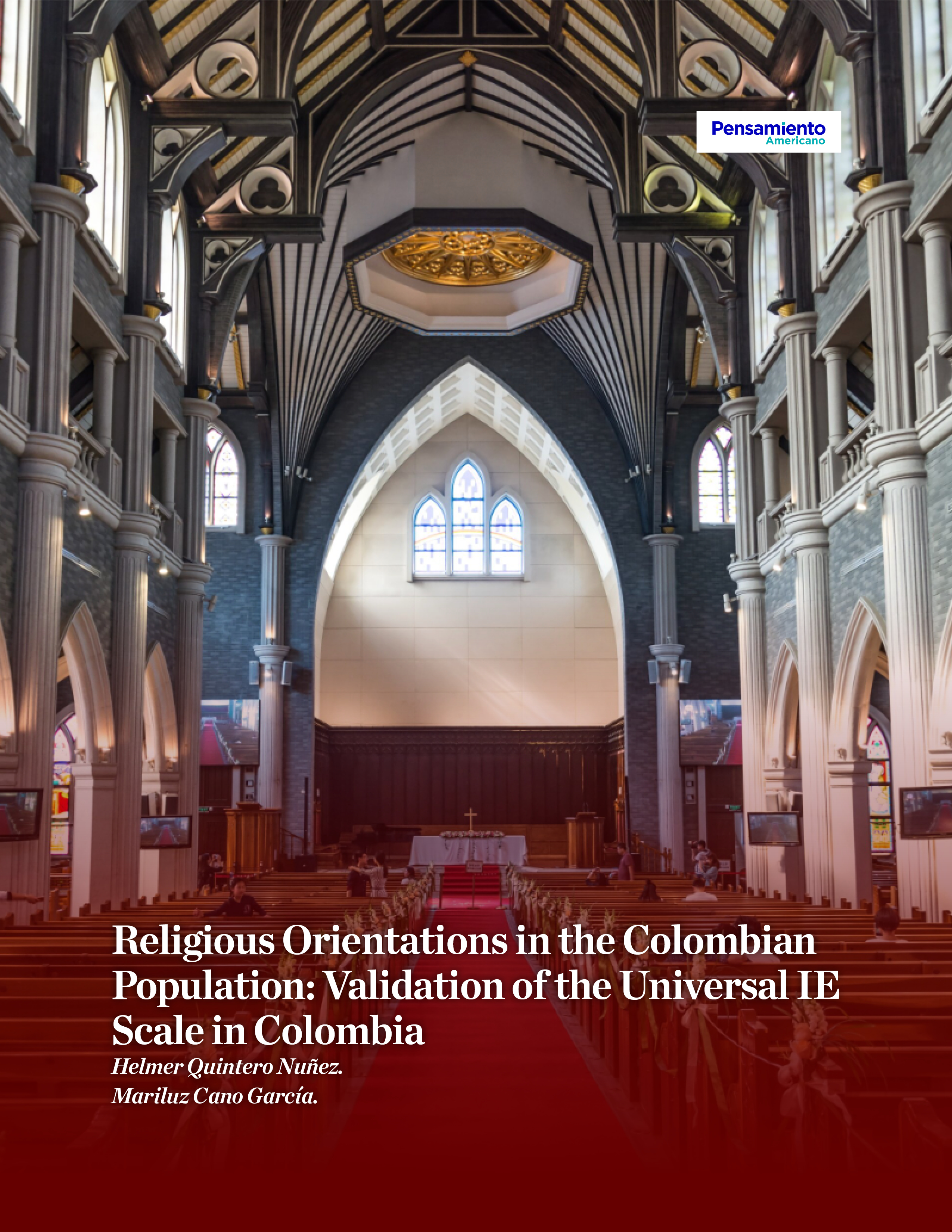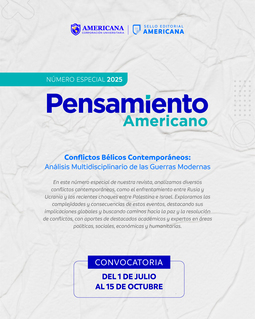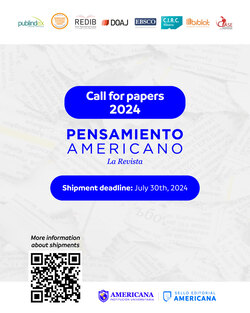Orientaciones Religiosas en la Población Colombiana: Validación de la Escala Universal IE en Colombia
DOI:
https://doi.org/10.21803/penamer.18.37.830Palabras clave:
Escala Universal de IE por edad, Religiosidad extrínseca, Religiosidad intrínseca, Psicometría, Motivación religiosaResumen
Introducción: La Psicología de la Religión estudia diversas variables, entre ellas la Orientación Religiosa, propuesta inicialmente por Allport y Ross (1967). Este constructo distingue entre la orientación intrínseca, que refleja una fe auténtica y comprometida, y la orientación extrínseca, que considera la religión como utilitarista (Kirkpatrick & Hood, 1989). Maltby (2002) desarrolló la escala Age Universal IE-12 para medir la orientación religiosa, que ha sido adaptada y validada en diferentes países, como Estados Unidos, Grecia, Inglaterra e Irlanda (Darvyri et al., 2014; Maltby, 1999). Objetivo: Este estudio tuvo como objetivo evaluar las propiedades psicométricas de la escala Age Universal IE-12 en una muestra colombiana para determinar su confiabilidad y validez en este contexto. Metodología: Se incluyeron 201 participantes de diferentes grupos religiosos: adventistas (25,4%), católicos (49,3%) y pentecostales (25,4%), de los cuales el 38% eran hombres y el 62% mujeres. Se administró la escala Age Universal IE-12 (Maltby, 2002) y se realizó un análisis factorial exploratorio y confirmatorio para evaluar sus propiedades psicométricas. Resultados: El análisis factorial exploratorio reveló una estructura trifactorial, que explica el 72% de la varianza, con un alfa de Cronbach de 0,82. El análisis factorial confirmatorio mostró que todos los índices de ajuste respaldan el modelo propuesto. Conclusiones: La escala demostró confiabilidad y validez consistente con hallazgos previos en México (Rivera-Ledesma et al., 2016) y Argentina (Simkin & Etchezahar, 2013), apoyando su aplicabilidad en el contexto colombiano.
Descargas
Referencias
Acosta Cruzado, R., & Sánchez Sánchez, J. (2017). Religiosidad y depresión en adultos mayores institucionalizados de Lima Metropolitana. Salud and Sociedad, 8(1), 22–34. doi:10.22199/S07187475.2017.0001.00002.
Allport, G. W. (1950). The individual and his religion: A psychological interpretation. Macmillan.
Allport, G. W. (1966). The religious context of prejudice.Journal for the Scientific Study of Religion, 5(3), 447–457. Retrieved from www.jstor.org/stable/1384172. doi:10.2307/1384172.
Allport, G. W., & Ross, J. M. (1967). Personal religious orientation and prejudice. Journal of Personality and Social Psychology, 5(4), 432–443. doi:10.1037/0022-3514.5.4.432, PubMed: 6051769.
Batson, C. D., Flink, C. H., Schoenrade, P. A., Fultz, J., & Pych, V. (1986). Religious orientation and overt versus covert racial prejudice. Journal of Personality and Social Psychology, 50(1), 175-181. doi:10.1037/0022-3514.50.1.175.
Batson, C. D., Schoenrade, P., & Ventis, W. L. (1993). Religion and the individual: A socialpsychological perspective. Oxford University Press.
Beltrán, C. W. M. (2013). Pluralización religiosa y cambio social en Colombia. Theologica Xaveriana, 63(175), 57-85.
Bentler, P. M., & Bonett, D. G. (1980). Significance tests and goodness of fit in the analysis of covariance structures. Psychological Bulletin, 88(3), 588-606. doi:10.1037/0033-2909.88.3.588.
Bollen, K. A. (1989). Structural equations with latent variables. doi:10.1002/9781118619179. John Wiley and Sons, Inc.
Brussino, S., & Etchezahar, E. (2015). Dimensiones del autoritarismo, centralidad de la religión y orientaciones religiosas: diferencias en el análisis lineal y no lineal de sus relaciones. Actualidades En Psicología, 29(118), 73-82.
Chiavenato, I. (1967). Administración de recursos humanos. Bogotá. McGraw-Hill.
Choi, Y. M., Kim, Y. M., Lee, J. H., & Lee, G. C. (2002). A preliminary study for the development and the standardization of Korean version of the intrinsic/Extrinsic Religious Orientation Scale. Journal of Korean Neuropsychiatric Association, 41, 1197-1206.
Darvyri, P., Galanakis, M., Avgoustidis, A. G., Pateraki, N., Vasdekis, S., & Darviri, C. (2014). The revised intrinsic/extrinsic religious orientation scale in a sample of Attica’s inhabitants. Psychology, 05(13), 1557-1567. doi:10.4236/psych.2014.513166.
Dawkins, R. (2017). El espejismo de Dios. Barcelona: Espasa Libros.
Deci, E. L., & Ryan, R. M. (1985). Intrinsic motivation and self-determination in human behavior. New York: Plenum Press.
Ellis, A. (1986). The case against religion: A psycotherapist´s view and the case against religiosity. American Atheist Press.
Flere, S., & Lavrič, M. (2008). Is intrinsic religious orientation a culturally specific American Protestant concept? The fusion of intrinsic and extrinsic religious orientation among non-Protestants. European Journal of Social Psychology, 38(3), 521-530. doi:10.1002/ejsp.437.
Francis, L. J., Village, A., & Powell, R. (September 13, 2016). Religious experience and religious motivation among Catholic and mainstream Protestant churchgoers in Australia: testing and applying five short measures. Mental Health, Religion and Culture, 19(8), 932-942. doi:10.1080/13674676.2016.1216532.
Gonçalves, B., Fagulha, T., & Sousa Ferreira, A. (2016). Intrinsic and extrinsic religious orientation in Portuguese Catholics. Mental Health, Religion and Culture, 19(8), 897-910. doi:10.1080/13674676.2017.1293627.
González Villanueva, M., & Reyes Lagunes, I. (2015). Orientación Religiosa, Identidad Grupal y Religiosidad como Predictores del Fundamentalismo Religioso. Acta De Investigación Psicológica, 5(2), 1984-1995. doi:10.1016/S2007-4719(15)30018-1.
Gorsuch, R. L., & McPherson, S. E. (1989). Intrinsic/extrinsic measurement: I/E-revised and single-item scales. Journal for the Scientific Study of Religion, 28(3), 348-354. doi:10.2307/1386745.
Gorsuch, R. L., & Venable, G. D. (1983). Development of an "age universal" I-E Scale. Journal for the Scientific Study of Religion, 22(2), 181-187. doi:10.2307/1385677.
Herzberg, F. (1959). The motivation to work. Wiley.
Homan, K. J., & Boyatzis, C. J. (2010). Religiosity, sense of meaning, and health behavior in older adults. International Journal for the Psychology of Religion, 20(3), 173–186. doi:10.1080/10508619.2010.481225.
Kaldestad, E., & Stifoss-Hanssen, H. (1993). Standardizing measures of religiosity for Norwegians. International Journal for the Psychology of Religion, 3(2), 111-124. doi:10.1207/s15327582ijpr0302_5.
Kirkpatrick, L. A. (1989). A psychometric analysis of the Allport-Ross and Feagan measures of intrinsic-extrinsic religious orientation. En M. L. Lynn & D. O. Moberg (Eds.), Research in the social scientific study of religion, 1. JAI Press.
Lavrič, M., & Flere, S. (2011). Intrinsic religious orientation and religious rewards: an empirical evaluation of two approaches to religious motivation. Rationality and Society, 23(2), 217-233. doi:10.1177/1043463111404670.
Maltby, J. (1999). The internal structure of a derived, revised, and amended measure of the religious orientation scale: the 'age-universal' I-E Scale - 12. Social Behavior and Personality, 27(4), 407-412. doi:10.2224/sbp.1999.27.4.407.
Maltby, J. (2002). The age universal I-E Scale-12 and orientation Toward religion: confirmatory factor analysis. Journal of Psychology, 136(5), 555-560. doi:10.1080/00223980209605550, PubMed: 12431038.
Maltby, J. (2005). Protecting the sacred and expressions of rituality: examining the relationship between extrinsic dimensions of religiosity and unhealthy guilt. Psychology and Psychotherapy, 78(1), 77-93. doi:10.1348/147608305X39644, PubMed: 15826407.
Maltby, J., & Day, L. (2002). Religious experience, religious orientation and schizotypy. Mental Health, Religion and Culture, 5(2), 163-174. doi:10.1080/13674670210144103.
Maltby, J., & Lewis, C. A. (1996). Measuring intrinsic and extrinsic orientation toward religion: amendments for its use among religious and nonreligious samples. Personality and Individual Differences, 21(6), 937-946. doi:10.1016/S0191-8869(96)00154-7.
Maslow, A. H. (1962). Toward a psychology of being. Van Nostrand Company.
Mcclelland, D. C. (1965). Toward A theory of motive acquisition. American Psychologist, 20, 321-333. doi:10.1037/h0022225, PubMed: 14323512.
Mora, L. E., Stavrinides, P., & McDermut, W. (2014). Religious fundamentalism and religious orientation Among the Greek Orthodox. Journal of Religion and Health, 53(5), 1498-1513. doi:10.1007/s10943-013-9734-x, PubMed: 23716083.
Pierre, J. (2001). ¿Fe o espejismo? En el cruce de la religión y la psicosis. Revista Práctica de Psiquiatría, 7(3), 163-172.
Rivera-Ledesma, A., Zavala Jiménez, S., & Montero-López, M. (2016). Validación de la Age Universal I-E Scale en sujetos mexicanos. Universitas Psychologica, 15(4), 15-14.vaus, doi:10.1114/Javeriana.upsy.
Shaw, A., & Joseph, S. (2004). Principal components analysis of Maltby and Day's (1998) amended quest religious orientation scale: A replication of the three component structure. Personality and Individual Differences, 37(7), 1425-1430. doi:10.1016/j.paid.2004.01.012.
Simkin, H., & Etchezahar, E. (2013). Las Orientaciones Religiosas Extrínseca e Intrínseca: validación de la “Age Universal” I-E Scale en el Contexto Argentino. Psykhe, 22(1).
Steiger, J. H., & Lind, J. C. (1980). Statistically-based tests for the number of common factors. Paper presented at the annual meeting of the Psychometric Society, Iowa City, IA.
Tucker, L. R., & Lewis, C. (1973). A reability coefficient for maximum likelihood factor analysis. Psychometrika, 38(1), 1-10. doi:10.1007/BF02291170.
Woolfolk, A. (2006). Psicología educativa. Pearson Educación.

Descargas
Publicado
Número
Sección
Licencia
Derechos de autor 2025 Pensamiento Americano

Esta obra está bajo una licencia internacional Creative Commons Atribución-NoComercial-SinDerivadas 4.0.
Bajo las condiciones siguientes:
-
Reconocimiento — Debe reconocer adecuadamente la autoría, proporcionar un enlace a la licencia e indicar si se han realizado cambios<. Puede hacerlo de cualquier manera razonable, pero no de una manera que sugiera que tiene el apoyo del licenciador o lo recibe por el uso que hace.
-
NoComercial — No puede utilizar el material para una finalidad comercial.
-
SinObraDerivada — Si remezcla, transforma o crea a partir del material, no puede difundir el material modificado.
- No hay restricciones adicionales — No puede aplicar términos legales o medidas tecnológicas que legalmente restrinjan realizar aquello que la licencia permite.





